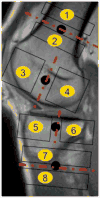In vitro assessment of knee MRI in the presence of metal implants comparing MAVRIC-SL and conventional fast spin echo sequences at 1.5 and 3 T field strength
- PMID: 24912802
- PMCID: PMC4297744
- DOI: 10.1002/jmri.24668
In vitro assessment of knee MRI in the presence of metal implants comparing MAVRIC-SL and conventional fast spin echo sequences at 1.5 and 3 T field strength
Abstract
Purpose: To assess lesion detection and artifact size reduction of a multiacquisition variable-resonance image combination, slice encoding for metal artifact correction (MAVRIC-SEMAC) hybrid sequence (MAVRIC-SL) compared to standard sequences at 1.5T and 3T in porcine knee specimens with metal hardware.
Materials and methods: Artificial cartilage and bone lesions of defined size were created in the proximity of titanium and steel screws with 2.5 mm diameter in 12 porcine knee specimens and were imaged at 1.5T and 3T magnetic resonance imaging (MRI) with MAVRIC-SL PD and short T1 inversion recovery (STIR), standard fast spin echo (FSE) T2 PD, and STIR and fat-saturated T2 FSE sequences. Three radiologists blinded to the lesion locations assessed lesion detection rates on randomized images for each sequence using receiver operating characteristic (ROC). Artifact length and width were measured.
Results: Metal artifact sizes were largest in the presence of steel screws at 3T (FSE T2 FS: 28.7 cm(2) ) and 1.5T (16.03 cm(2) ). MAVRIC-SL PD and STIR reduced artifact sizes at both 3T (1.43 cm(2) ; 2.46 cm(2) ) and 1.5T (1.16 cm(2) ; 1.59 cm(2) ) compared to FS T2 FSE sequences (27.57 cm(2) ; 13.20 cm(2) ). At 3T, ROC-derived AUC values using MAVRIC-SL sequences were significantly higher compared to standard sequences (MAVRIC-PD: 0.87, versus FSE-T2 -FS: 0.73 [P = 0.025]; MAVRIC-STIR: 0.9 vs. T2 -STIR: 0.78 [P = 0.001] and vs. FSE-T2 -FS: 0.73 [P = 0.026]). Similar values were observed at 1.5T. Comparison of 3T and 1.5T showed no significant differences (MAVRIC-SL PD: P = 0.382; MAVRIC-SL STIR: P = 0.071).
Conclusion: MAVRIC-SL sequences provided superior lesion detection and reduced metal artifact size at both 1.5T and 3T compared to conventionally used FSE sequences. No significant disadvantage was found comparing MAVRIC-SL at 3T and 1.5T, although metal artifacts at 3T were larger. J. Magn. Reson. Imaging 2015;41:1291-1299. © 2014 Wiley Periodicals, Inc.
Keywords: MAVRIC-SL; artifact reduction; magnetic resonance imaging (MRI); periprosthetic imaging.
© 2014 Wiley Periodicals, Inc.
Figures





Similar articles
-
Accelerated metallic artifact reduction imaging using spectral bin modulation of multiacquisition variable-resonance image combination selective imaging.Magn Reson Imaging. 2020 Oct;72:19-24. doi: 10.1016/j.mri.2020.06.012. Epub 2020 Jun 20. Magn Reson Imaging. 2020. PMID: 32574683
-
MR imaging near metallic implants using MAVRIC SL: initial clinical experience at 3T.Acad Radiol. 2015 Mar;22(3):370-9. doi: 10.1016/j.acra.2014.09.010. Epub 2014 Nov 27. Acad Radiol. 2015. PMID: 25435186 Free PMC article.
-
Metal artifact reduction with MAVRIC SL at 3-T MRI in patients with hip arthroplasty.AJR Am J Roentgenol. 2015 Jan;204(1):140-7. doi: 10.2214/AJR.13.11785. AJR Am J Roentgenol. 2015. PMID: 25539249 Free PMC article.
-
MR Imaging with Metal-suppression Sequences for Evaluation of Total Joint Arthroplasty.Radiographics. 2016 Jan-Feb;36(1):209-25. doi: 10.1148/rg.2016150075. Epub 2015 Nov 20. Radiographics. 2016. PMID: 26587889 Review.
-
Imaging the knee in the setting of metal hardware.Magn Reson Imaging Clin N Am. 2014 Nov;22(4):765-86. doi: 10.1016/j.mric.2014.07.009. Epub 2014 Aug 28. Magn Reson Imaging Clin N Am. 2014. PMID: 25442032 Review.
Cited by
-
TREAT Early Arthralgia to Reverse or Limit Impending Exacerbation to Rheumatoid arthritis (TREAT EARLIER): a randomized, double-blind, placebo-controlled clinical trial protocol.Trials. 2020 Oct 16;21(1):862. doi: 10.1186/s13063-020-04731-2. Trials. 2020. PMID: 33076964 Free PMC article.
-
3 T: the good, the bad and the ugly.Br J Radiol. 2022 Feb 1;95(1130):20210708. doi: 10.1259/bjr.20210708. Epub 2021 Nov 10. Br J Radiol. 2022. PMID: 34705565 Free PMC article. Review.
-
[Metallic Artifacts on MR Imaging and Methods for Their Reduction].Taehan Yongsang Uihakhoe Chi. 2020 Jan;81(1):41-57. doi: 10.3348/jksr.2020.81.1.41. Epub 2020 Jan 31. Taehan Yongsang Uihakhoe Chi. 2020. PMID: 36238112 Free PMC article. Review. Korean.
-
Multiacquisition Variable-Resonance Image Combination Magnetic Resonance Imaging Used to Study Detailed Bone Apposition and Fixation of an Additively Manufactured Cementless Acetabular Shell.Arthroplast Today. 2020 Aug 26;6(4):694-698. doi: 10.1016/j.artd.2020.07.019. eCollection 2020 Dec. Arthroplast Today. 2020. PMID: 32923552 Free PMC article.
-
Towards a simplified fluid-sensitive MRI protocol in small joints of the hand in early arthritis patients: reliability between modified Dixon and regular Gadolinium enhanced TSE fat saturated MRI-sequences.Skeletal Radiol. 2023 Jun;52(6):1193-1202. doi: 10.1007/s00256-022-04238-8. Epub 2022 Nov 28. Skeletal Radiol. 2023. PMID: 36441238 Free PMC article.
References
-
- Hayter CL, Koff MF, Potter HG. Magnetic resonance imaging of the postoperative hip. J Magn Reson Imaging. 2012;35(5):1013–25. - PubMed
-
- Koch KM, Lorbiecki JE, Hinks RS, King KF. A multispectral three-dimensional acquisition technique for imaging near metal implants. Magn Reson Med. 2009;61(2):381–90. - PubMed
Publication types
MeSH terms
Substances
Grants and funding
LinkOut - more resources
Full Text Sources
Other Literature Sources
Medical

